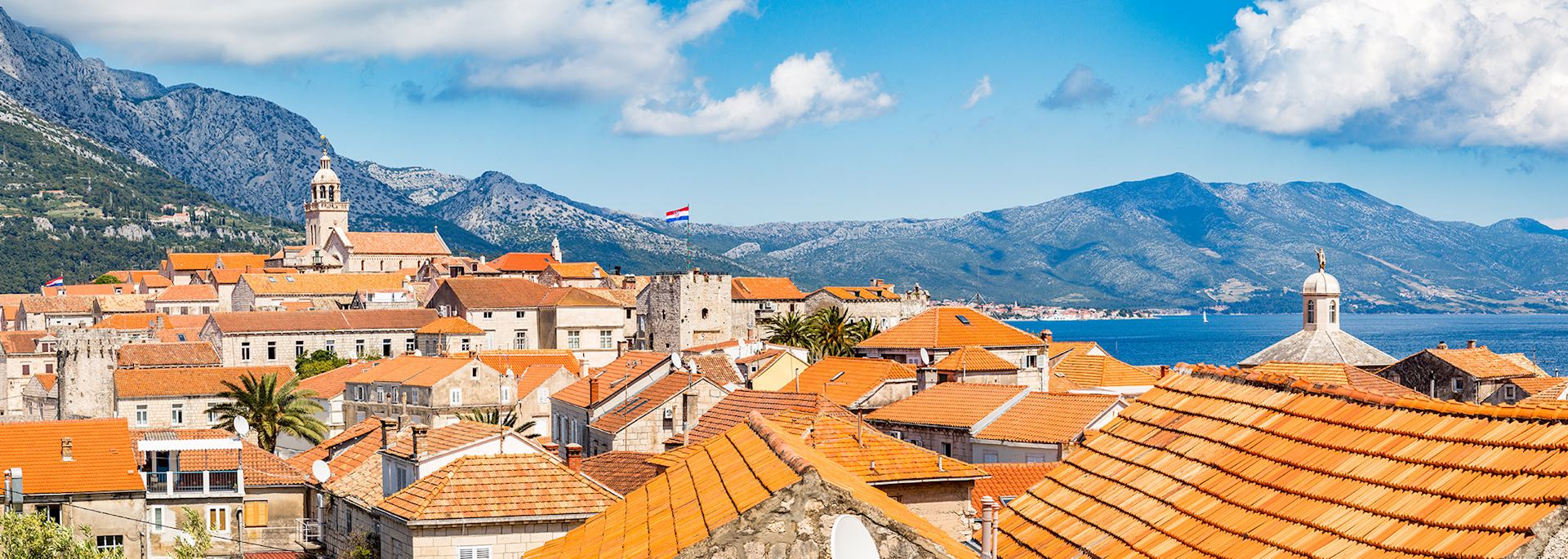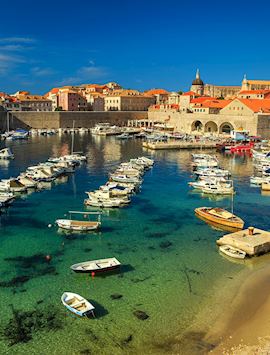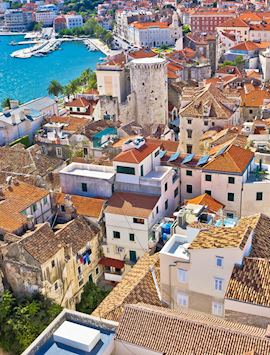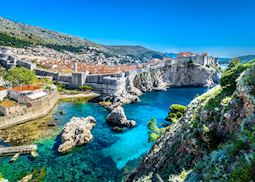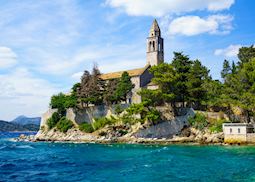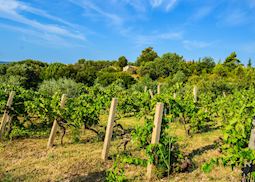Jump to:
With sandy beaches, historic towns, olive groves and vineyards, the island of °´Ç°ůÄŤłÜ±ô˛ą offers the quintessential Mediterranean without the crowds. One of Croatia’s most relaxing summer destinations, it has a rich history and culture along with a well-preserved medieval town as its focal point.
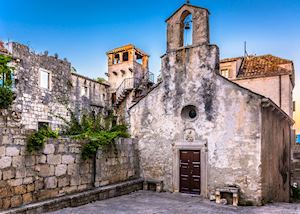 °´Ç°ůÄŤłÜ±ô˛ą has been inhabited since Mesolithic times. Although the forests that led the ancient Greeks to call it Korkyra Melaina (Black Corfu) are no longer so dense, it’s a lush place where traditional culture remains strong.
°´Ç°ůÄŤłÜ±ô˛ą has been inhabited since Mesolithic times. Although the forests that led the ancient Greeks to call it Korkyra Melaina (Black Corfu) are no longer so dense, it’s a lush place where traditional culture remains strong.
The long, narrow island sits just 3 km (2 miles) from mainland Croatia. Its main town — which shares its name with the island — is set on a headland in the northeast and surrounded by water on three sides. Often referred to as ‘Little Dubrovnik’, thanks to its medieval walls and churches, grand squares and Venetian palaces, °´Ç°ůÄŤłÜ±ô˛ą is particularly impressive when seen from the water.
Although °´Ç°ůÄŤłÜ±ô˛ą changed hands regularly over the years, it had strong ties to the Venetian Empire from the 15th to the 19th centuries, which is most evident in its architecture. On the main square, the 15th-century Saint Mark’s Cathedral is built in Gothic-Renaissance style with a slim bell tower and sculptural details. Inside, you’ll find paintings by Tintoretto.
Wander the surrounding streets and you’ll come across smaller churches hidden on the quiet lanes and little squares, as well as Gothic, Renaissance and Baroque palaces that once belonged to the town’s aristocratic families.
For many years, the island flourished as an artistic hub. It was the birthplace of one of Croatia’s most illustrious writers, Petar Kanavelić, in the 17th century. Although disputed and backed by scant evidence, °´Ç°ůÄŤłÜ±ô˛ą is also often cited as the birthplace of Marco Polo. Progressively, the town abolished slavery in 1214.
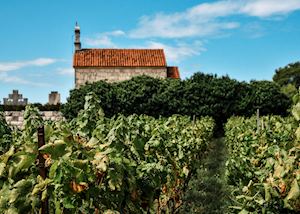 Driving southeast from °´Ç°ůÄŤłÜ±ô˛ą through olive groves and pine forests, you reach Lumbarda, a small fishing village set around a quiet bay. The hills behind are blanketed with vines and foster several wineries, which produce good-quality dry whites from the grk grape.
Driving southeast from °´Ç°ůÄŤłÜ±ô˛ą through olive groves and pine forests, you reach Lumbarda, a small fishing village set around a quiet bay. The hills behind are blanketed with vines and foster several wineries, which produce good-quality dry whites from the grk grape.
Continue along the coast and you’ll find quiet coves and small sandy beaches. Of them, Pupnatska Luka on the south coast is considered the best Adriatic beach of all.
While most visitors stick to the eastern end of the island, there are small fishing villages with pebble stone beaches all along the coast and some great hiking and biking trails in the highland areas where villagers live off small-scale wine and olive oil production. The towns here date mostly from the Roman era, though many were badly affected by the phylloxera outbreak in the mid-20th century.
Vela Luka on the westernmost tip of the island has some museums and art galleries and a prehistoric cave nearby. Inland, at Ĺ˝rnovo, you can visit traditional olive mills, while the small towns of ÄŚara and Smokvica are known for their white wines. Produced from the indigenous pošip grape, they’re considered some of the best of all Croatian whites.
Visiting the island’s smaller villages, you’re bound to come across folk music and dance performances, including the local sword dance, the Moreška.
Off the island’s shores, you can take snorkelling trips, visit Mljet National Park or venture to remote islands such as Lastovo.
°´Ç°ůÄŤłÜ±ô˛ą lies about 100 km (62 miles) northwest of Dubrovnik and, if you’d prefer a quieter base, it’s easy to stay in °´Ç°ůÄŤłÜ±ô˛ą and visit Dubrovnik for a day.
Best time to visit °´Ç°ůÄŤłÜ±ô˛ą
°´Ç°ůÄŤłÜ±ô˛ą is at its best in spring (April to June) and autumn (September to October), when warm temperatures and fewer visitors make it an extremely pleasant place to explore. July and August get very hot and busy, and much of the island shuts down for winter between November and March.
who's been there
-
01993 838 92501993 838 234
- Make an enquiry
Suggested itineraries featuring °´Ç°ůÄŤłÜ±ô˛ą
Our itineraries will give you suggestions for what is possible when you travel in °´Ç°ůÄŤłÜ±ô˛ą, and they showcase routes we know work particularly well. Treat them as inspiration, because your trip will be created uniquely by one of our specialists.
Places near °´Ç°ůÄŤłÜ±ô˛ą
- Hvar 22 miles away
- µţ°ů˛ąÄŤ 30 miles away
- Dalmatian Coast 35 miles away
- Ĺ ´Ç±ôłŮ˛ą 45 miles away
- Split 47 miles away
- Trogir 53 miles away
- Dubrovnik 63 miles away
- Ĺ ľ±˛ú±đ˛Ôľ±°ě 76 miles away
- Zadar 118 miles away
- Plitvice Lakes 150 miles away
- Pula 204 miles away
- Zagreb 205 miles away
- Istria 216 miles away
- Rovinj 221 miles away
Photos of °´Ç°ůÄŤłÜ±ô˛ą
Our expert guides to exploring °´Ç°ůÄŤłÜ±ô˛ą
Written by our specialists from their own experiences of visiting °´Ç°ůÄŤłÜ±ô˛ą, these guides will help you make the most of your time there. We share both our practical recommendations and the best ways to appreciate °´Ç°ůÄŤłÜ±ô˛ą at its best.
-
A highlights guide to Croatia ![City walls, Dubrovnik]()
A highlights guide to Croatia
A highlights guide to Croatia
From the brilliantly blue waters of the Adriatic to the vineyards of Istria, Croatia specialist Caroline outlines five highlights of any trip to Croatia, including two cities where Game of Thrones was filmed.
Read this guide
Accommodation choices for °´Ç°ůÄŤłÜ±ô˛ą
We've selected a range of accommodation options for when you visit °´Ç°ůÄŤłÜ±ô˛ą. Our choices usually come recommended for their character, facilities and service or location. Our specialists always aim to suggest properties that match your preferences.
-
![Hotel Korcula De La Ville, Korcula]()
Aminess Korcula Heritage Hotel
°´Ç°ůÄŤłÜ±ô˛ą -
![Lesic Dimitri Palace, Korcula]()
Lešić Dimitri Palace
°´Ç°ůÄŤłÜ±ô˛ą
Ideas for experiencing °´Ç°ůÄŤłÜ±ô˛ą
Our specialists seek out authentic ways to get to know the places that could feature in your trip. These activities reflect some of the experiences they've most enjoyed while visiting °´Ç°ůÄŤłÜ±ô˛ą, and which use the best local guides.
-
Elaphiti Islands private boat tour ![Franciscan monastery on Lopud, Elaphiti Islands]()
Elaphiti Islands private boat tour
Elaphiti Islands private boat tour
An archipelago of 13 islands (only three of which are inhabited), off the Dalmatian Coast near Dubrovnik, the Elaphiti Islands offer historic villages, pine forests and karst scenery as well as leisurely swimming and snorkelling in crystalline waters.
View details -
Peljesac wineries and Ston oyster tasting ![Plavac mali vineyards, Peljesac Peninsula]()
Peljesac wineries and Ston oyster tasting
Peljesac wineries and Ston oyster tasting
Meet the producers of some of Croatia’s finest wines and seafood on a tour of the Dalmatian Coast. Take in two wineries and an oyster farm, where you can sample their products and hear about the work that goes into creating them.
View details -
Tastes of °´Ç°ůÄŤłÜ±ô˛ą tour ![Cathedral of Saint Mark, °´Ç°ůÄŤłÜ±ô˛ą]()
Tastes of °´Ç°ůÄŤłÜ±ô˛ą tour
Tastes of °´Ç°ůÄŤłÜ±ô˛ą tour
Sample local honey and wine, learn about food traditions, and get an insight into daily life of the artisan food producers on °´Ç°ůÄŤłÜ±ô˛ą Island on this private, half-day tour which includes a three-course meal made from the island’s finest products.
View details
